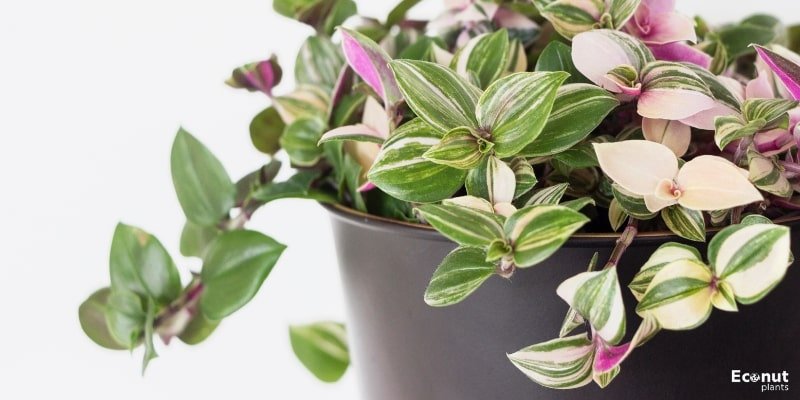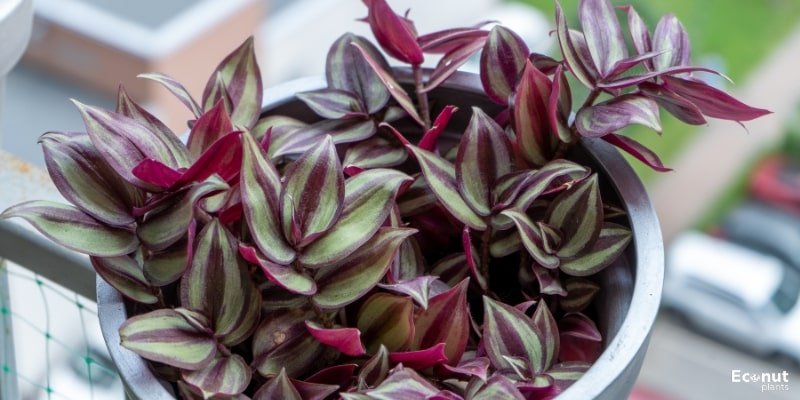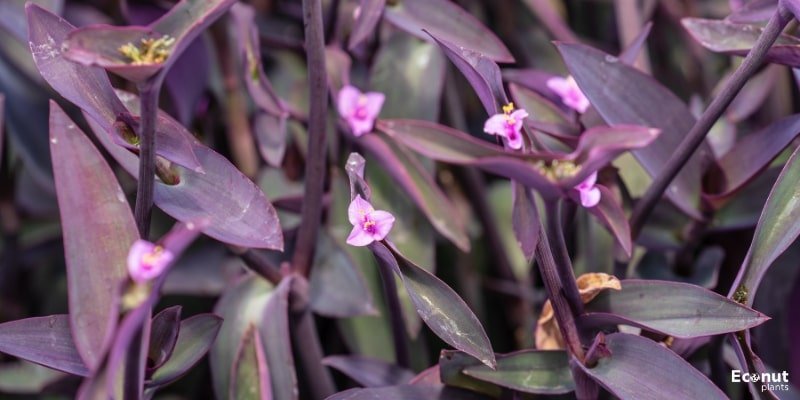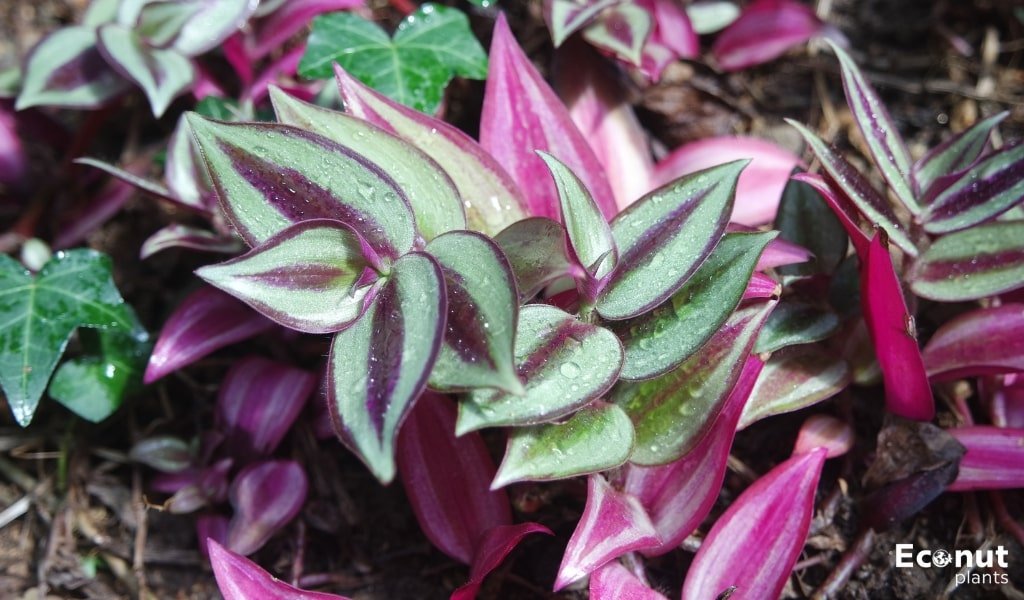The inch plant, sometimes known as the Wandering Jew, is credited with originating the entire plant-swapping craze. Native to tropical and temperate regions, the Wandering Jew grows quickly and requires little maintenance.
The vibrant purple leaf of Tradescantia zebrina, formerly called Zebrina pendula, is what makes this creeper species so popular all over the world. Even those without much gardening knowledge can grow tradescantia in their home gardens year-round when they are planted indoors in containers.
Wandering Jew Plant Overview
| Common Name | inch plant, flowering inch plant |
| Scientific Name | Tradescantia zebrina, Tradescantia fluminensis |
| Family | Commelinaceae |
| Height | 6 feet up |
| Light | Bright, indirect light |
| Water | Average-medium |
| Soil | Slightly moist |
| Fertilizer | Half-strength liquid |
| Pests and Diseases | Spider mites, aphids, leaf spot, root rot |
3 Main Types of Wandering Jew Plants
“Wandering Jew” and “wandering dude” are colloquial terms for three different species belonging to the Tradescantia genus. Zebrina, pallida, and fluminensis are these species.
1. Tradescantia fluminensis ‘Quicksilver’

This type of white-flowering wandering Jew is a popular houseplant. It is an evergreen perennial native to southeast Brazil in South America that grows well in temperate areas.
The oval-shaped, dark green leaves of this plant give it a glossy appearance. They cling to meaty stems, which facilitate the easy development of roots from the stem’s nodes.
Triangular white blooms with three petals are produced by the leaves. These can grow singly or in clusters, but they don’t generate seeds.
2. Tradescantia zebrina ‘Tricolor’

The widely used houseplant Tradescantia zebrina, which is a member of the Commelinaceae family, is known for its variegated leaves. The zebra plant has attractive, purplish-green foliage with silver stripes.
For the budding gardener, this is the plant! It can thrive in almost any indoor environment due to its remarkable hardiness. Grown as an annual or outdoors in mild weather (zones 9–11) where it does not freeze, this delicate perennial native to southern Mexico and Guatemala can also be grown as an annual.
The plant Tradescantia zebrina is regarded as invasive in some regions. This includes Australia, Hawaii, and Brazil, where the species is found in moist, forested areas and grows well.
3. Tradescantia pallida ‘Purple Heart’

This particular type of wandering Jew is incredibly beautiful and originated in eastern Mexico. Its leaves are tall and pointed, with a maximum length of seven inches. Sometimes the tips of the leaves stay red or green while the rest of the leaf becomes purple.
Along their whole length, the stems are distinctly segmented. This has contributed to its invasiveness in regions experiencing warmer temperatures. The plant can swiftly reroot itself from the joints, where it is more brittle and prone to breaking off. Propagation from cuttings is also made incredibly easy by this.
In colder areas, the likelihood of it spreading is significantly reduced. Because Tradescantia pallida is not tolerant of cold temperatures, it will wither away in the winter.
It yields only a few blooms. Typically, they have three petals, which might be lavender, pink, or white. Although they aren’t very obvious, they make a lovely contrast with the vivid foliage.
Wandering Jew Plant Care
The Wandering Jew plant can bring lovely colour to any home garden and is rather easy to grow in Indian climes. It is a delight to grow and a wonderful plant for novice plant parents. Let’s examine the comprehensive care advice for creeping inch plants.
Most spiderwort plants are easy-going. Finding the ideal moisture level is one of the few issues with growing this as a houseplant.
Light
Bright indirect light is the ideal environment for houseplants like Wandering Jew. If it receives more light, your wandering Jew plant will blossom more profusely. Without adequate sunlight, the foliage’s brilliant colours will wane.
If you decide to move your plant outside for the summer, make sure it stays shaded or partially shaded to protect it from the midday light.
Soil
You can plant your wandering Jew in regular houseplant potting soil, but they’ll thrive even better in soil that has more organic content in it.
Add a little peat moss, perlite, and organic compost to your potting mix. Water the plant, watch which direction the soil prefers to travel, and make necessary adjustments to achieve the optimal balance between water retention and drainage. PH values of 5 to 6 are optimal for soil.
Water
The wandering Jew plant prefers its potting mix to be consistently damp but never waterlogged. Water your wandering Jew plant once a week or when the top soil dries out if it is in indirect light. Keep the soil from drying up entirely.
To make sure the soil absorbs all of the water and doesn’t simply flow out of the planter; moisten your dried potting mix in stages. Water the soil a little at first, allowing it to absorb the moisture for a while before adding more water until the drainage hole at the bottom of the planter is filled.
Temperature and Humidity
The ideal temperature range for your inch plant is between 60 and 80 degrees Fahrenheit. If the plant is exposed to frost, it will die. Light frosts, however, might not harm plants in USDA hardiness zones 9 through 11. The plant might reappear in the spring if its leaves die back in these locations.
Container-grown plants should be moved inside when the outside temperature is regularly below sixty degrees Fahrenheit. Your plant can withstand heat much better than cold, yet extreme heat may sear its leaves.
The optimal relative humidity for Tradescantia plants is 70%. If you’re indoors, you may achieve the ideal humidity levels by misting plants daily with distilled or filtered water or by using a plant humidifier.
Fertilizer
Apply a general-purpose, well-balanced houseplant fertilizer to your wandering Jew plant. They are not heavy feeders, and they respond well to foliar and root treatments every 15 days.
Use a high-quality fertilizer for this, such as Ugaoo Plant Tonic. Apply the fertilizer directly to the roots once every fifteen days, dilute it as directed, and apply it via a misting spray once every fifteen days.
The greater size and visual appeal are assured by the foliar treatment. But avoid overfeeding the plant, since this will result in the leaves losing their variegation.
Pruning
Pruning is not necessary for the spiderwort plant. For creeping-inch plants, pruning is necessary in two situations: first, to get rid of dead leaves, and second, to control the plant’s shape and growth pattern. Spiderwort plants grow lanky on their own; to keep your plant bushier, periodically trim the stems or pinch back at least 1/4 of the branch length.
Just cut at an angle in between leaf nodes using sharp, clean pruning shears or scissors to remove stems at the desired length. You can simply pinch off dead or yellowing leaves, making sure to separate the leaf stalk from the main stem in the process.
Pests
Spider mites are the most common pests that you may encounter with wandering Jew plants. Maintaining high humidity levels or misting your wandering Jew plant is an effective way to combat them because they prefer warm, dry environments.
If it doesn’t work, you can remove the mites from the plant by giving it a water bath. Infested areas should be removed, and a systemic pesticide should be used for even more serious infestations.
Additionally, aphids feed on the sap from the stray leaves of Jewish plants. If your plants are grown inside, you can move them outside and give them a strong watering or a treatment with neem oil. If aphids persist, follow up and reapply treatments in 7 to 10 days.
Diseases
The majority of illnesses you’ll encounter are caused by overwatering. There are two main causes of root rot in most houseplants:
1. You’re using too much water.
2. Your soil holds too much moisture.
Just water less frequently if issue #1 is present! To solve issue #2, incorporate coarse sand or perlite into your soil mixture. To enhance drainage, you can further place rocks at the pot’s bottom.
On leaves, other fungal diseases such as leaf spot, botrytis, and powdery mildew manifest as black patches, wet lesions, and white, powdery materials, in that order.
Remove any damaged leaves if any of this shows. Treat these illnesses the same way you would rot, since they flourish in the same environments.
Take the plant out of the pot and discard it if none of your remedies work. Don’t reuse any of the soil, and thoroughly clean the pot before using it again.
FAQ
1. What does pinching a plant mean?
A pruning technique called pinching is usually applied to young plants and the terminals of newly growing stems. Pinching Tradescantias encourages bushier growth.
2. Does wandering Jew spread?
Yes. Rapid growth and out the competence of native vegetation are features of several Tradescantia species. Before putting the plant in the ground, think about this and whether it is considered an invasive species. All Tradescantias, fortunately, look beautiful in containers.
3. Will the wandering Jew make it through the winter?
Even though established plants may tolerate occasional light frost and these plants are quite resilient, prolonged cold will kill the above-ground portions of the plants. It might come back in the spring, but it’s unlikely.

